March 31, 2017
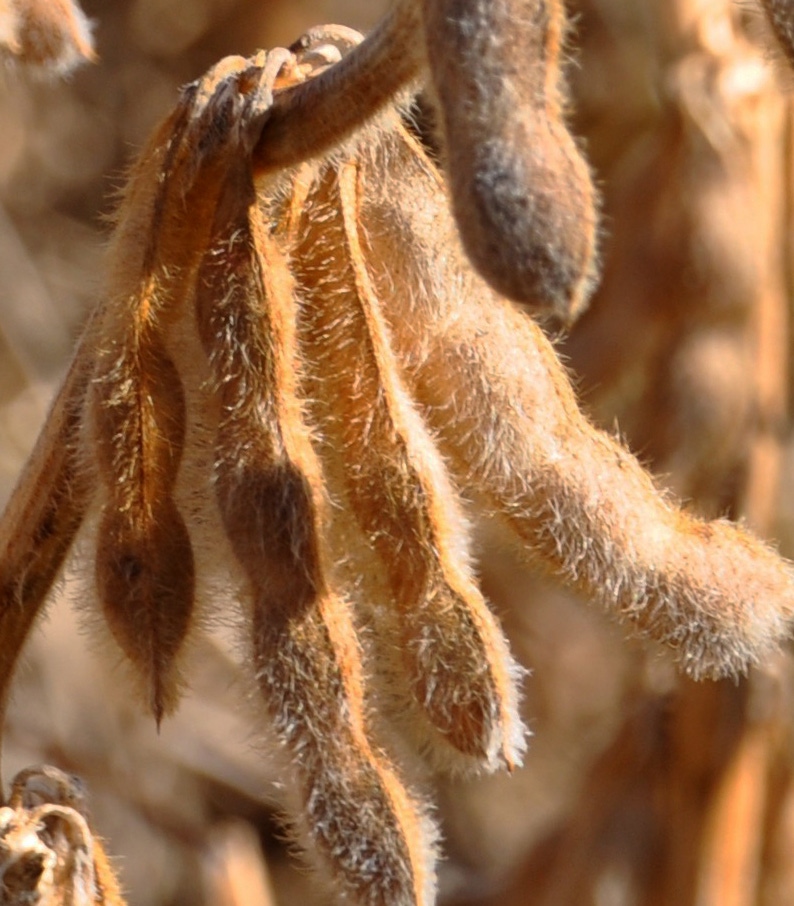
THINK Different.
Iowa State University cropping systems scientist Dr. Sotirios Archontoulis aims his soybean yield research at understanding the complex dynamic interactions between soils, crops, climate and management. In a recent modeling project, he looked at all those factors to try to learn the primary differences that resulted in 107- to 122-bushel soybean yields at Kip Cullers’ farm in southwest Missouri compared to more common 45- to 55-bushel yields in ISU fields near Ames, Iowa. What he found surprised him, and might surprise you, too.
------------
Dr. Sotirios Archontoulis knows that soil organic matter, nitrogen (N) cycling, soybean varieties, temperatures, rainfall, fertilization, planting dates/rates and more goes into the equation that determines soybean yields. “No single factor can predict and explain yield levels and variability,” he says. “There are a lot of interactions, and you need a systems approach to understand the complex dynamics of growing soybeans.”
Still, when the Iowa State University (ISU) Assistant Professor of Integrated Cropping Systems posed the question about which factor was most important for record yields—soil conditions, management, cultivar characteristics, or weather—he was surprised at the role management played on radiation interception and conversion to biomass.
“I thought weather, variety and soil conditions were really important, and they are, but I was surprised at how much more yield we could expect with proper management that allows soybean varieties to intercept and efficiently use more light to produce biomass and grain,” Archontoulis says.
Similar radiation energy
“Before the analysis, I thought that radiation levels were higher in Missouri compared to Iowa but that wasn’t the case. Both fields received about the same radiation energy. So it’s a matter of interception and utilization of this energy—management is the key here. Theoretically, a 100 megajoule per square meter in extra radiation interception in August produces about 10 extra bushels for soybeans. An average sunny day provides about 25 megajoules per square meter in Iowa.”
Archontoulis put the soils, crops, climate and management inputs that resulted in 107- to 122-bushel soybean yields at Kip Cullers’ farm in southwest Missouri into a crop systems model (APSIM; Agricultural Production Systems sIMulator) and compared them to inputs for the 45- to 55-bushel yields in ISU fields near Ames, Iowa. He compared inputs and outputs for crop years 2011-2013. Data from Kip Culler’s field over 2011-2013 were taken from literature (Ryan J. Van Roekel and Larry C. Purcell; Crop Sci. 54:1–8 (2014).
More biomass, more yield
His modeling shows that interception of sunlight (20% more) and radiation use efficiency (conversion of light to biomass, 15% more) produced more biomass to account for much of the doubling (60-bushels plus per acre increase) in Culler’s field compared to yields in Ames. “The harvest index—grain to biomass ratio—was the same between fields; the higher yield was a result of greater biomass production,” Archontoulis says.
In 2011, Ames yields were 55 bu/acre compared to Cullers yield of 109 bu/acre. In 2012, a dry year, irrigation was a key component to Cullers yield of 107 bu/acre compared to 46 bu/acre yields in Ames. A non-irrigated, non-fertilized field Cullers used for comparison that year yielded only 18 bu/acre, illustrating the importance of irrigation when rainfall was limited. In 2013, when rainfall was less of a yield-limiting factor at the Cullers farm, his field with no irrigation or fertilizer yielded 58 bu/acre compared to 45 bu/acre in Ames, but his field with irrigation and manure application yielded a whopping 122 bu/acre. The Archontoulis model credits irrigation for a 46% increase and increased radiation use efficiency with another 68% of the yield jump.
More water and fertility
Water requirements go up for high yields, as well as fertility requirements. “Frequent irrigation application decreases canopy temperature to relieve stress, as well as supplies water needs. Higher nutrient application rates also reduce stress to the plant. If more nitrogen is available to the soybean plant, it doesn’t have to expend energy fixing it and perhaps this energy can be allocated towards biomass production,” Archontoulis reasons.
“Maximum photosynthesis at the Culler farm was achieved throughout the growing season with high nutrient levels—the 120 bu/acre yields were achieved with 650 pounds of N uptake. This means that the application of nitrogen (via manure) to the soil was at least in the magnitude of 1,000 lbs. N/acre. Soil N mineralization and N-fixation contributed little to the total N uptake as simulated by the model. Archontoulis’ model didn’t include an economics analysis of nutrient application.
Archontoulis has run 37 weather-years of simulations in model scenarios that show varieties with a 12% increase in radiation use efficiency could result in 75 bu/acre yields, compared to baseline yields of 66 bu/acre from 1980 to 2016. Those yields bump up to above 80 bu/acre if the radiation use efficiency increase is coupled with early planting (April 24) and 3.5 maturity group soybeans. Although this analysis was for central Iowa, similar results would be expected for other locations in Iowa, Archontoulis says.
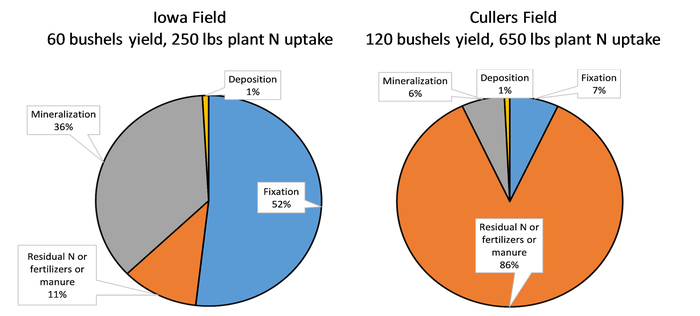
Narrow rows, more seeds
Yields go higher again with 15-inch row spacing, and higher yet by adding heavy seeding rates (145,000 seeds/acre.) If soil moisture is not limiting or irrigation is added to that mix, soybean yields could approach 90 bu/acre in Archontoulis’ model.
The radiation intercepted during the growing season on Cullers’ farm was 20% more than that of Ames. “The growing season is shorter here in Iowa—if we could have fewer cloudy days especially during August, that would make a big difference,” Archontoulis says. “But we can’t make that happen, so we need to find other ways to help soybeans intercept more sunlight and become more efficient at converting that sunlight into biomass.”
That’s not an easy thing to do, Archontoulis acknowledges, but he believes it’s possible. “Model scenario analysis indicated that boosting yield levels from 65 bushels per acre to 100 bushels per acre in central Iowa requires a combination of different practices, not just one change,” Archontoulis says. (See charts).
Convert more light to biomass
“What we have to remember is increasing yields from 65 to 100 bu/acre will be a multi-step approach and experience,” Archontoulis says. “Changing just one factor alone – an earlier planting date, a longer maturity, N fertilization, or irrigation – will not work in most cases if we don’t first manage for #1, 2 and 3 (see sidebar story). We have to increase the demand (biomass production) to see a response to supply (nitrogen).”
Current research shows a radiation use efficiency factor of 1.25 in Cullers’ field, compared to .73 in a typical central Iowa field near Ames. “The typical RUE value used in crop models is .88,” Archontoulis says. “There isn’t any evidence that root growth limits soybean yields. What we need to shoot for is more light interception and efficient conversion of radiation into higher yields.”
Harnessing sunlight key to high soybean yields
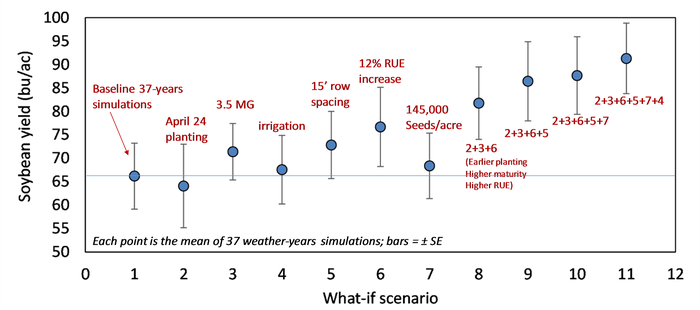
High yield combo
Different combinations (right side of graph) of early planting, longer maturity varieties, irrigation, 15” row spacing, increased radiation use efficiency and higher seeding rates would boost soybean yields the most, up to 90 bu/acre, according to an ISU crop model.
Graphic courtesy ISU
Soil conditions, soybean cultivars, and weather are all important factors in achieving record soybean yields. But an Iowa State University analysis of a “systems approach” coupled with modeling shows one key to higher yields is cultivars with longer maturity dates, coupled with management that increases light interception and supplies nutrients and water in ways that maximize radiation use efficiency.
Tips to bump bean yields over 100
After running 37 weather-years of model simulations, Iowa State University cropping systems scientist Dr. Sotirios Archontoulis believes more producers could achieve 100-bushel per acre and even higher soybeans yields. His model scenario analysis indicates it will take a combination of practices, though, rather than a single change in management.
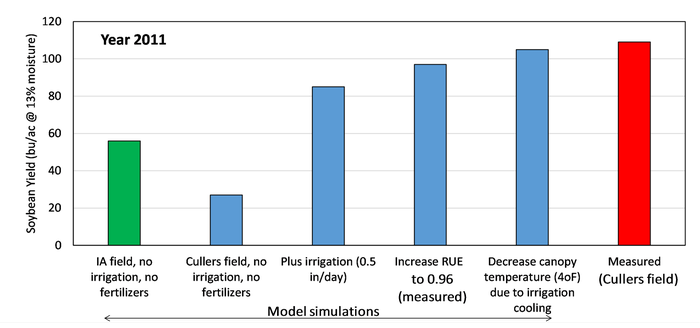
Blue bars in a model simulation show how a combination of factors grew yields on Kip Cullers farm in 2011. Red bar is actual yield, green bar is comparison to average yields in central Iowa.
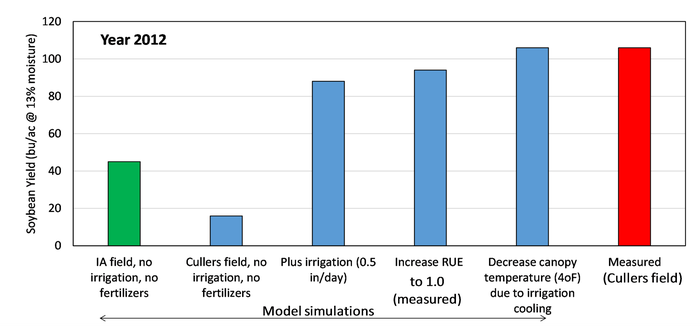
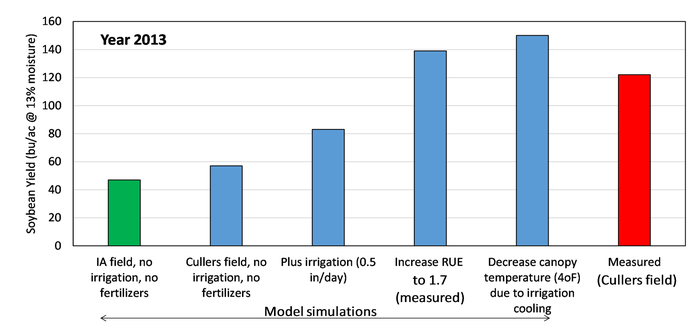
Archontoulis studied yield winner Kip Cullers’ operation in Missouri and modeled the differences in average yields vs. Cullers’ record yields (see graph “scenario to 100 bushels/acre yields”). After that exercise, Archontoulis has three practical tips for Iowa soybean farmers to increase and perhaps even double current yields:
1) Manage for maximum light harvest (narrower rows);
2) Manage for “green” and “healthy” canopy throughout the season--every megajoule counts!);
3) Manage for non-limiting P, K and other micronutrients in the soil.
“Everything counts towards achieving a high conversion efficiency of light to biomass,” Archontoulis says.
Also consider:
4) Planting date and maturity variety. Planting date and maturity set the yield potential—both choices are very important. If you set a low yield potential at the start of the season, there is nothing that you can do later on to increase yields. A combination of earlier planting and longer maturity increases yield potential (more days to grow, more light interception, theoretically higher yields).
5) Irrigation. Irrigation pays off in the sandy soils within the Cullers field in Missouri. In his fields with high daily temperatures, the canopy temperature cooling offered by irrigation is also very important. But Iowa is different. The Iowa soils have a higher capacity to store water and shallow water tables, so water doesn’t limit plant growth.
6) Nitrogen. We have to find the optimum balance between N fixation, soil inherent fertility and nitrogen application in Iowa. For yield levels up to 70-80 bushels, nitrogen from fixation and soil organic matter mineralization is probably enough. Once other factors are optimized, we should deal with extra N application in Iowa.
7) Increased radiation use efficiency. This is all about taking maximum advantage of sunlight to convert radiation to plant growth. It includes management to ensure all needed nutrients and water are available to maximize the power of sunlight in the photosynthesis process. That means higher nitrogen rates as well. All systems should be “go” when the sun shines.
8) Higher seeding rates. While most studies show soybean plants compensate for one another at lower seeding rates, when maximum yields are the goal, and all other factors are topped out for 100-bushel yields, more plants can be supported, and they will make more use of available sunlight during the growing season.
About the Author(s)
You May Also Like




